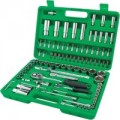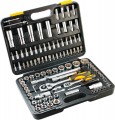Total number of items
The total number of core items included in the set.
In this case, the main items are all devices that are directly used during work: non-separable tools (traditional wrenches, hammers, pliers ...), elements of collapsible tools (for example, a ratchet for removable heads and 5 such heads will be considered 6 units) , as well as accessories (such as extensions or universal joints). Additional accessories — such as lights — may or may not be included in this count, depending on the manufacturer; however, there are usually few such accessories, and they do not fundamentally affect the total number of items.
The most modest modern tool kits include
up to 25 units. However, such kits are very popular — they are inexpensive and at the same time can be very versatile.
25 – 50 items is still quite a small number,
50 – 75 pcs can be called an average,
76 – 100 items are more than average, and the most extensive modern sets can include
100 – 150 items or even
more.
The general rules for choosing this parameter are obvious: a more extensive set, usually, is more multifunctional, but more expensive, weighs more and takes up more space. It is also worth bearing in mind that with a similar number of items, the specific assortment of these items in differ
...ent sets may be different; so when choosing, it is worth specifying not only the number of tools, but also their specific composition.Square drive size
The size of the "seat" for which the socket heads included in the package are designed (see below), in other words, the size of the square hole on the back of the head used for installation on a ratchet, wrench or other similar tool. Accordingly, the tool for working with heads supplied in the kit has the same dimensions of the landing square; and in the absence of such tools in the kit, data on the size of the heads will be useful for its selection.
There is a generally accepted standard for these sizes, providing for the designation in fractions of an inch — from 1/4 "to 1". Thanks to this, heads and tools from different sets can be quite compatible — just matching in size is enough. Most often in modern hand sets there are options in 1/4 "and 1/2", a little less often — 3/4" and 3/8". Some sets include several variants of the landing square at once.
Socket heads (6 points)
Number of
hex sockets included in the tool kit.
All end heads are accessories for a collapsible tool; during operation, they are mounted on a ratchet, wrench or other similar device. The head itself has the appearance of a characteristic “cap”, which, during operation, is put on a bolt, nut, etc. This design, among other things, allows you to work with parts located in recesses and some other hard-to-reach places that cannot be reached with open-ended, captive or split keys. And compared to a set of classic socket wrenches, the holder plus socket set takes up much less space, providing almost the same functionality.
As for the 6 faces, this type of socket head is the most famous and widespread, because. most modern nuts and bolts have this shape.
Socket heads (E-profile)
The number
of E-profile sockets supplied with the tool kit.
All end heads are accessories for a collapsible tool; during operation, they are mounted on a ratchet, wrench or other similar device. The head itself has the appearance of a characteristic “cap”, which, during operation, is put on a bolt, nut, etc. This design, among other things, allows you to work with parts located in recesses and some other hard-to-reach places that cannot be reached with open-ended, captive or split keys. And compared to a set of classic socket wrenches, the holder plus socket set takes up much less space, providing almost the same functionality.
Specifically, this type of heads has a working part in the form of a six-pointed star, which is why such nozzles are also called “asterisks”, “Torx” or “internal Torx”. The latter option is used to avoid confusion with Torx keys (see above): the working part of such a key (“external Torx”) has the form of a star-shaped rod, while in the end head the working part has the form of a recess with similar outlines. As for the use of such heads, when used with “native” fasteners, the E-profile allows you to work at high forces without much risk of breaking the edges; and fasteners are used for such tools, in particular, in cars.
Socket heads sizes (E-profile)
Working size range of E-profile sockets (see above) supplied with the kit. This parameter allows you to evaluate how the heads fit the dimensions of the fasteners with which they are planned to be used.
Bits
The number of
bits supplied with the tool kit.
A bat in this case is called a working nozzle, which plays the role of a screwdriver tip; in fact, they are most often used with screwdriver handles (see above).
Many types of splines (slots) are used in modern fasteners — starting with the well-known
straight, cross-shaped (
Phillips and
Pozidriv),
Torx sprockets and ending with exotics like Torq-set (a cross with lines shifted from the centre), Pentalobe (with five ledges), etc. .P. In addition, the size of the slots can also vary, and in many cases, tool matching in size is very important. Accordingly, the more bits supplied with the set, the more versatile it is, the higher the probability that it will contain a nozzle of the desired type and size. However, the specific list of bits in the kit also does not hurt to clarify — in order to make sure that it has all the varieties you need. In the characteristics of individual sets, these data are given in the paragraph "Bit sizes" (see below).
Adapter
An adapter for docking seemingly incompatible elements from a set. For example, socket heads with an unsuitable landing square on a ratchet, screwdriver handle or in a drill driver.
The adapter provides full-fledged work with all the required list of tools from the set.
Extension
The type of extension included with the tool kit.
Extensions refer to "intermediate" devices, if necessary, installed between the main tool (like a screwdriver handle, see above) and the working nozzle. As the name implies, they allow you to increase the length of the working part of the tool — for example, to get to hard-to-reach places. Here are the main options for such devices:
—
Hard. Rigid rod extension. It does not give such freedom of action and the ability to get to hard-to-reach places as flexible (see below), but it is considered more reliable, allows you to develop great efforts (often the same as when working without an extension cord) and even allows the use as an improvised lever. Some rigid extensions may also have a crank function (see above).
—
Flexible. An extension in the form of a flexible tube, usually made of a metal spiral. Such an extension, like a universal joint (see above), allows you to position the nozzle at an angle to the axis of rotation of the main tool — while the range of such angles is much wider (in some cases they can reach 180 °), and the long length and high mobility of the device are even more expands freedom of action. The disadvantage of flexible extensions is less suitability for work with greater efforts than the rigid ones described above.
— Rigid/flexible. This option is indicated for sets equipped with both types of
...extensions described above. This makes it possible to choose an option depending on the specific situation.
If there are several extensions of the same type in the kit, they, usually, differ in the size of the attachment (see "Landing square").Also in kit
Additional items included with the toolbox but not listed above. Here are some of those items:
— Adapter. Adapter from one type of mount to another. Quite often, adapters are designed to fit magnetic bits (see above) with a hex shank into a tool that uses a landing square, but there may be other options — for example, adapters between different sizes of the mentioned squares (see above).
— Holder for bits. A specific type of adapter designed to mount bits with a conventional hex shank in screwdrivers where a shank with a notch for a retainer is required. In extreme cases, they can also be used as improvised screwdrivers. Several holders can be supplied, in such cases they usually differ in length.
— Level. A tool for assessing the position of a particular surface. The simplest levels are for testing whether a surface is horizontal or not; however, tool kits usually include more advanced fixtures that allow you to also control verticality, and in some cases also check compliance with a 45 ° tilt and even measure a specific angle of deviation from the horizontal / vertical.
— Depth limiters. They are used together with drills (see above). They allow you to set the maximum drilling depth — the tool simply will not go further; this is useful in cases where you need to make holes of a given depth.
— Telescopic magnetic probe. A device in the form of an extendable rod (like an antenna or a pointer) with a strong permanent magnet at...the end. Facilitates the collection of small metal parts — for example, crumbled bolts or bits — including and in hard-to-reach places (like the space under the cabinet or a narrow gap between the boards).
— Lamp. Classic flashlight for lighting in dark places.
— Tester. He's an indicator. A specialized screwdriver for searching for a phase in electrical networks during electrical work. The indicator rod is almost completely covered with insulation, and a light bulb is located in the transparent handle. Such a device can also be used as a classic screwdriver, but it is not designed for applying great efforts — the main purpose is to search for the phase.
— Fastening devices — for example, screws with dowels. In normal cases, it is more convenient to buy fasteners separately, for specific needs; however, there are situations when the "emergency stock" provided in the kit is very handy.
This list is not exhaustive — manufacturers may provide other equipment, sometimes very specific.

